While visiting mosque and shrine complexes in and around Istanbul I became aware of the importance of çinar trees to urban architecture in Turkey. The çinar (chinar in Farsi,Platanus orientalis) thrives from the Balkans to the Himalayas and has graced the shrines, gardens and lieux de mémoire of all the civilizations of that zone. Çinars are very long-lived trees, up to 700 or even 1000 years. Like the long-lived trees of other climes, such as oaks and baobabs, mature çinars inspire awe. Some are even imbued with the numinous.

Detail of a 16th century Persian miniature showing a Sufi meditating in the trunk of a çinar. (source: front cover of the paperback edition of Henry Corbin’s Histoire de la philosophie islamique, Paris: Gallimard, 1986, The image credit inside the cover does not identify the manuscript. It says only that it is the property of the Reza-ye Abbasi Museum in Tehran)
In the Ottoman heartland, venerable çinar trees grow in nearly every great mosque complex. Even after they die their stumps are left standing and are carefully tended.
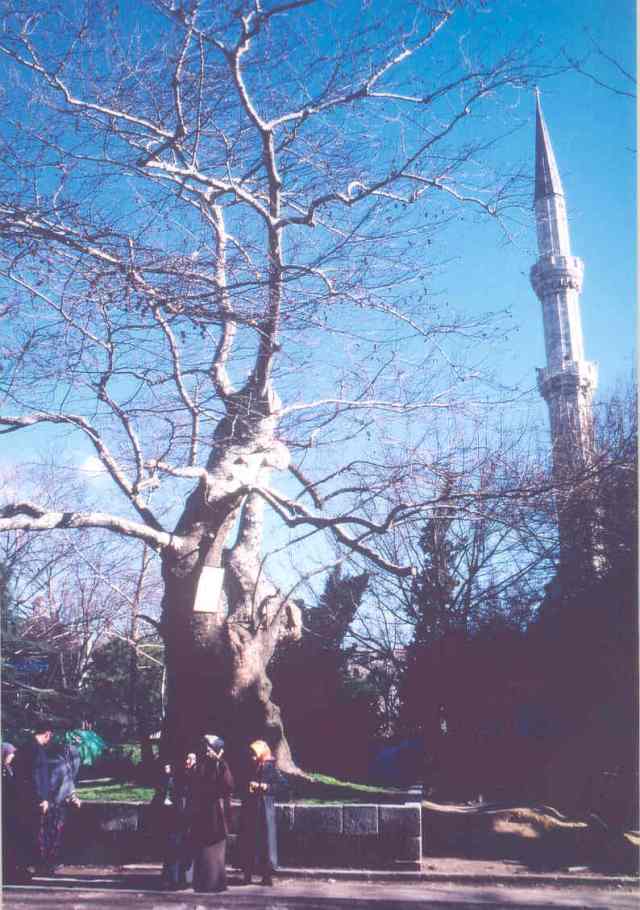
This venerable çinar on the grounds of the Şehzade Mosque also appears to be venerated. I saw people walk up and touch it reverentially before moving on. (ph. Eric Ross)
Atik Valide complex in Üsküdar
A large çinar grows on each side of the şardivan (ablution fountain) in the courtyard of the Atik Valide Mosque in Üsküdar.

Courtyard of the Atik Valide Mosque in Üsküdar, showing the çinar trees framing the şardivan. (ph. John Shoup)
The Atik Valide (aka Eski Valide) complex was built in the 1570s for valide(queen/regent/queen mother) Nur Banu (d. 1583). It was designed by Mimar Sinan and is a fine example of Sinan’s famed mastery of site.
The huge complex occupies the crest and southern slope of a hill. The upper part consists of the mosque (at the very top of the hill), a medrese (college), two other schools (a darül kura and a darül hadis), a tekke (Sufi lodge), a cemetery and a library. The lower part consist of an immense caravanserai, a tabhane (hostel), a darü şifa (hospital) and animaret (kitchen & dining hall). The hamam (bath house) is at the bottom of the slope, where the water pressure is highest (Sinan began his career as a hydraulic engineer). Sinan also took advantage of the slope in other ways. Many of the utilities of the lower part of the complex are housed in vaulted chambers beneath the schools of the upper part. Themedrese is high enough above the street to its west that its dershane (classroom) is built on vaults above it. This is also the case of the dershane of the tekke on the slope to the north. According to legend, the hollow trunk of an old çinar in the courtyard of the tekkewas used by a Sufi master for khalwa (spiritual retreat).
Valide Sultan Nur Nanu clearly had commerce on her mind. Her complex in Üsküdar catered to Anatolian and Asian merchants. Parts of it are still used for warehousing though much of the lower part of the complex is in poor condition and deserves to be rehabilitated. The upper part however, and the mosque with its large front porch and its ample courtyard in particular, remains as enchanting as ever. The portico around the courtyard is pierced by large windows which allow views out over the rooftops. It is a fitting monument to this valide, one of the most powerful women of her day.
Eyüp Sultan
Similar to that of Atik Valide Mosque in Üsküdar, and perhaps its inspiration, is the courtyard of Eyüp Sultan, Istanbul’s most popular shrine. The courtyard lies between the mausoleum of Abu Ayyub al-Ansari, a companion of the Prophet who is believed to have died during the siege of Constantinople in 670, and the mosque to its south. Several greatçinars, some living, some dead, shade the courtyard.
The shrine is the nucleus of an immense cemetery which covers the slope of the hill to its north. Eyüp Sultan has been a favored burial ground of the city’s great men and women since Sultan Mehmed conquered it. The lower part of the cemetery, adjoining the mosque-mausoleum complex, is marked by their charitable institutions.
The Eyüp medrese (or dârül kurâssi) was a gift of my favorite Ottoman statesman, Sokollu Mehmed Paşa (1506-1579). Apart from being a brilliant statesman–he served the aforementioned Valide Sultan Nur Banu–the man had great taste. He commissioned much of Sinan’s best work. At his funerary complex in Eyüp (which Sinan may have designed) the medrese is linked to his türbe (mausoleum) by a short portico.

View of Sokollu Mehmed Pasa’s funerary complex in Eyüp, showing the portico between the medrese (left) and his mausoleum (right). (ph. Eric Ross)
The imaret at Eyüp was established by Mihrişah Valide Sultan in 1792. Since then its immense kitchen and dinning hall has accommodated countless numbers of pilgrims and poor people. The beautiful sebil (fountain) and the valide’s exquisite türbe on the corner frame the imaret to form an elegant façade along this path to the shrine. It has recently been meticulously restored. (see this site)

View of Mihrişah Valide Sultan’s mausoleum, on the corner of her imaret complex. The imaret’s sebil is visible behind it, across from the multi-domed funerary complex of Hüsrev Paşa (ph. Eric Ross)
The shrine and cemetery of Eyüp Sultan are shaded by mature çinars. It is a beautiful place and makes for a great outing.
Topkapı
Aged stumps of great çinars like the ones in the courtyard in Eyüp Sultan can be found at many historic sites. The second court of Topkapı Palace has several of them.
Koca Mustafa Paşa
There are some interesting trees at the Koca Mustafa Paşa shrine. This place started out as a shrine to Saint Andrew in Crete (d. 766), who was buried next to a church already consecrated to Saint Andrew. It had a monastery and a nunnery. It remained in possession of Christians until 1486, when Koca Mustafa Paşa (d. 1512) converted the church into a mosque. The monastery was turned into a tekke for the Halvetiye (Khalwatiyah) order whose great sheikh at the time, Sünbül Efendi (d. 1529), was buried there. The shrine has since served as the home of the Sunbuliye branch of the Halvetiye and many of their sheikhs are buried there. The complex also includes a medrese, southwest of the mosque, for the study of exoteric religious science. It was built by Defterdar (treasury minister) Ekmekçizade Ahmet Paşa (d. 1618).
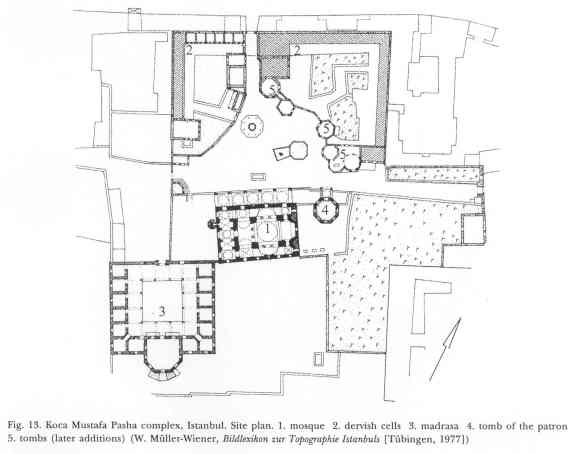
Layout of Koca Mustafa Pasa complex. (Source: Yürekli, Zeynep (2003), “A Building between the Public and Private Realms of the Ottoman Elite: The Sufi Convent of Sokollu Mehmed Pasha in Istanbul,” inMuqarnas, vol. 20. p. 171)

Plan of the Koca Mustafa Paşa shrine complex. The neighborhood to its north preserves Istanbul’s traditional urban fabric while residential neighborhood to the south results from mid-twentieth century urban renewal.
The transformation of the church into a mosque required the re-orientation of the building. The mosque opens north, through an add-on porch , whereas the church was entered from the west, through a narthex which no longer serves that purpose.
The courtyard between the mosque and the tekke is dominated by the stump of an ancient Cyprus tree. Half-fallen, the stump emerges from a wooden kiosk and is prevented from collapsing altogether by some metal braces. Inside the kiosk is an iron chain hanging from the trunk which, according to the legend, was used to determine the truthful party in disputes.
Directly in front of the mosque’s porch is another tree shrine. It marks the grave of Sidika Hatun, a Byzantine princess who converted to Islam.
I am in great admiration at the respect shown for trees, and especially mature trees, in Turkish cities. Bursa (topic of my next post) has adopted the çinar as a civic symbol. Every single çinar in that city, and there must be thousands, is registered with its department of public works.
Even after they die their trunks are left standing, protected, and thus continue to exist in the cityscapes and architectural complexes. Such respect is in stark contrast to what I have grown used to in Morocco. Here, trees of all ages and species are regularly and mercilessly hacked back by municipal authorities. This includes the trees in and around historic sites.
No trip to Istanbul is complete without a visit to Mimar Sinan’s tomb. I go there to thank him for having adorned our world with so much beautiful architecture.
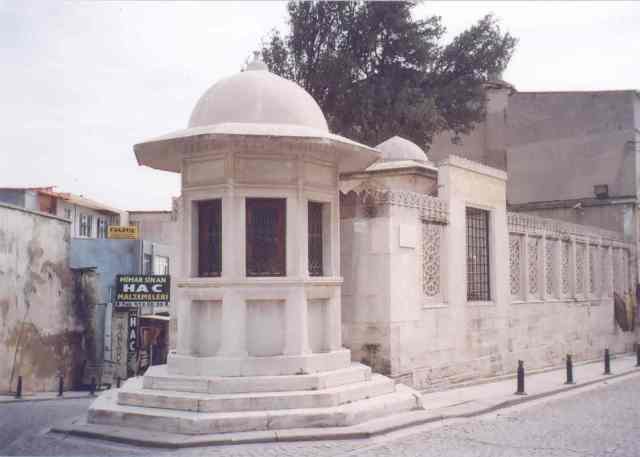
The tomb of Mimar Sinan occupies a triangular lot next to the Süleymaniye Complex. Its octagonal sebil occupies the corner of the site. Behind it is the architect’s tomb and a little garden, sheltered from the streets on each side by a stone screen. (ph. Eric Ross)
Bibliography
There are lots of books about Mimar Sinan. By far the most complete study of his art and era is:
- Necipoğlu, Gülru (2005), The Age of Sinan: Architectural Culture in the Ottoman Empire, London: Reaktion Books.
Here are a few others:
- Egli, Hans G. (1997), Sinan: An Interpretation, Istanbul: Ege Yayınları
- Pierpont, Ann (2007), Sinan Diaryz: A Walking Tour of Mimar Sinan’s Monuments, Istanbul: Çitlembik Publications.
- Rogers, J. M. (2006), Sinan, I. B. Tauris/Oxford Centre for Islamic Studies (Makers of Islamic Civilization series).
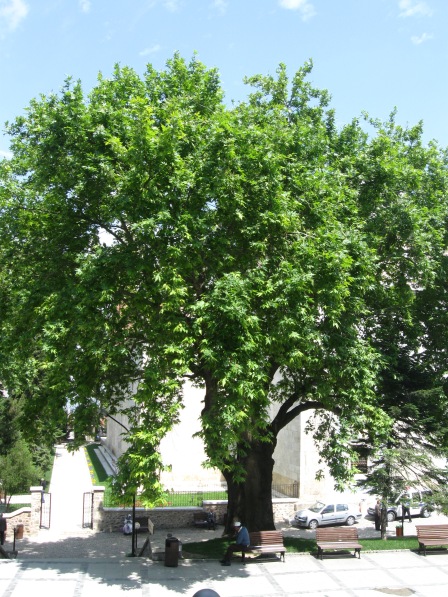 In memory of Kemal Satir
In memory of Kemal Satir
Shortly after having posted about çinar tress Filiz Satir, a writer based in the State of Washington, contacted me. She had recently lost her father, as had I, and was searching for a photo of a çinar to adorn his gravestone. I was enchanted by the cross currents in our fathers’ itineraries. Both men were engineers. In the mid-1950s Kemal Satir (1927-2011), an electrical engineer, emigrated from Turkey first to Canada and then to the USA. At the very same time, my father’s company transferred him from Canada to Turkey. Both men then began raising their young children in their new country.
Filiz has brought the çinar to mark her father’s grave in two ways: first by engraving its image, and secondly by reading this poem by Arif Ocakçı Ocakbey:
Ulu ÇınarÇınar ağaçları.
Uzun yaşar.
Sevgisini göklere.
Acısını toprağa.
Güzelliğini yeşilini.
Yaprağa verir.
Sende öyle ol.Çınar ağaçları.
Çok heybetli olur.
Göklere bakar.
Güneşle dost.
Işıkla, sarmaş dolaş olur.
Sende öyle ol.Çınar ağaçları.
Bir sevda taşır yüreğinde.
Yüreğinin başında.
Kuşlar konar dalına.
Sende öyle ol.
Barışı sevgiyi.
Taşıyarak öl.Çınar ağaçları.
Sevecen umutlu olur.
Kollarını açar.
Göklere durur.
Bir tarihi barışı yazar.
Bir sevgiyi yaşar, yaşatır.
Sende öyl ol.Çınar ağaçları kolayca ölmez.
Yüzyıllarca yaşar durur.
Zamana meydan okur.
Kötülüğe meydan okur.
Yiğit bir asker gibi durur.
Sende öyle ol.
Adın gibi ulu ÇINAR OL.
In memory of Kemal Satir, on the one-year anniversary of his passing. Read among family at his grave, August 11, 2012.
Filiz Satir has translated this poem into English. I post it here with her permission, and in memory of her father.
Noble ChinarChinar tree lives so very long.Sending its love to the skiesand pain into the earth.A veridian beauty, bearing leaves.So you should be.Chinar tree, a stargazingfan of the heavens,a fast friend to the sun.He embraces the light.So you should be.Chinar tree is home to birdsperching on its branches.With a canopy spreading love farand wide, he is a devotee of peace.So you should be.Chinar tree, compassionatebeing, whose open arms endwhere the skies begin. History’srecord keeper, inspiring love for life.So you should be.Chinar does not easily die.He lives hundreds of yearsbefore the end comes.He defies the passage of time,defies ill will and wrongdoing.Like a brave solider,Chinar stands strong.So you should be.Be as the Noble Chinar.






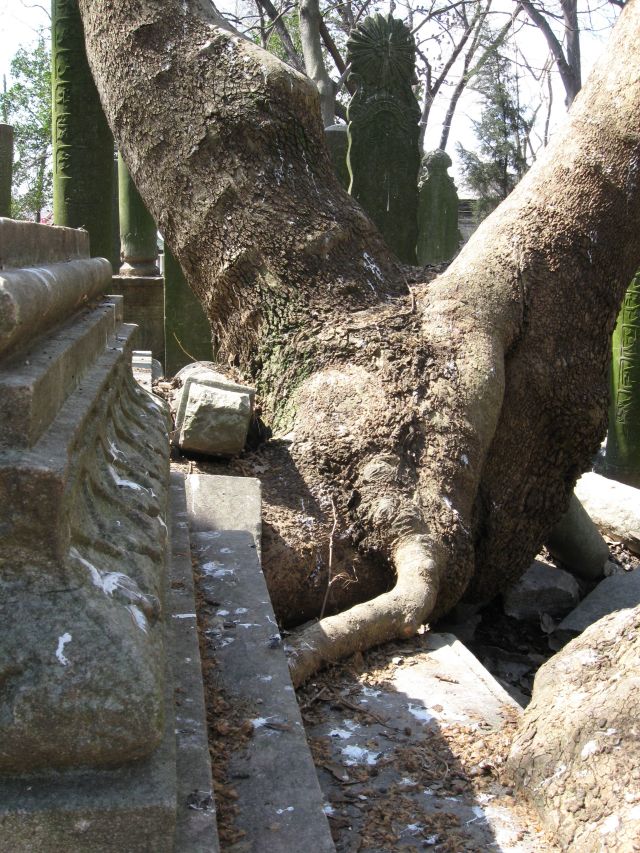




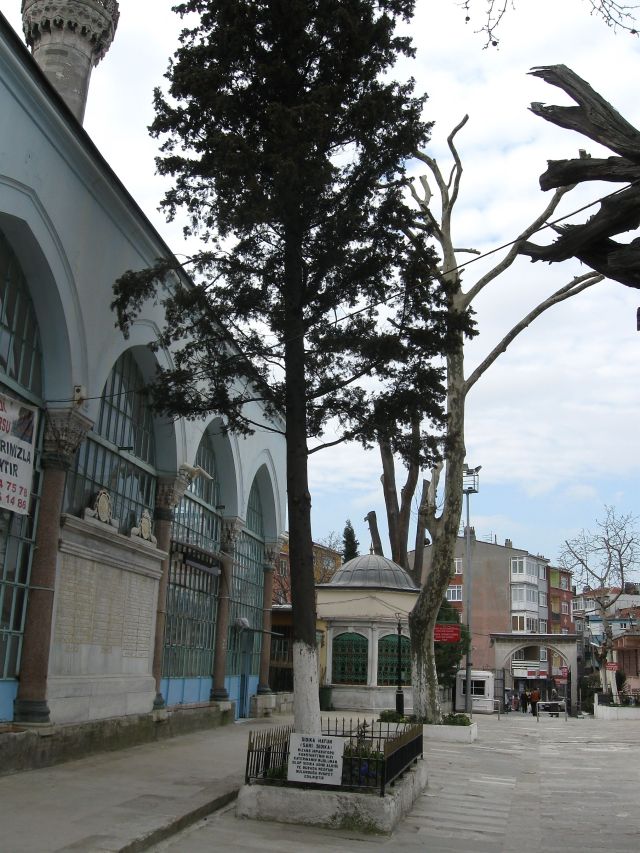
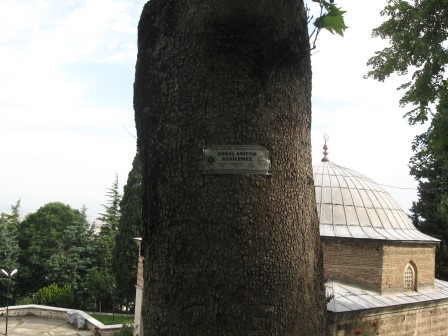
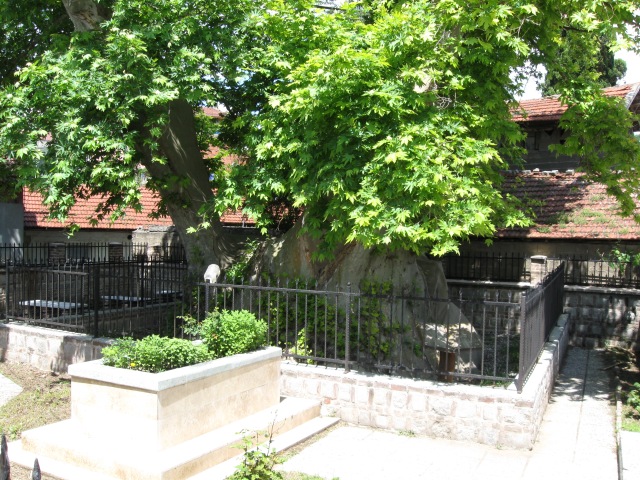
Hiç yorum yok:
Yorum Gönder